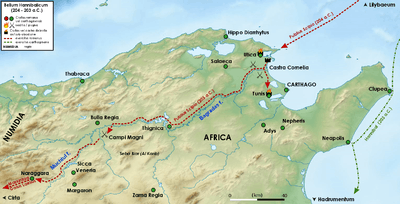Battle of the Great Plains
The Battle of the Great Plains (Latin: Campi Magni), also known as the Battle of the Bagrades, was a battle fought between Scipio Africanus of Rome and a combined Carthaginian and Numidian army late in the Second Punic War. It occurred on the plains south of Bulla Regia around the upper Bagradas River (the classical name of the Medjerda). The attack was designed as a diversionary tactic by Rome to disrupt Hannibal's attack on Italy. By defeating the Carthaginians, Scipio Africanus caused Hannibal to leave Italy and return to Africa, where he was later defeated at Zama.
| The Battle of the Great Plains | |||||||
|---|---|---|---|---|---|---|---|
| Part of Second Punic War | |||||||
 Italian-language map of Scipio's African campaign | |||||||
| |||||||
| Belligerents | |||||||
|
Massylii |
Masaesyli | ||||||
| Commanders and leaders | |||||||
|
Scipio Africanus Masinissa Gaius Laelius |
Hasdrubal Gisco Syphax | ||||||
| Strength | |||||||
|
Not stated (Polybius) 12,000–20,000 (modern estimates) |
30,000 (Polybius)
| ||||||
| Casualties and losses | |||||||
| Unknown | Death, capture, or rout of the army | ||||||
Prelude
Hasdrubal and Syphax had both succeeded in escaping from their camps, which the Roman general Scipio Africanus and his Numidian allies, under Masinissa, had destroyed. Hasdrubal and Syphax fell back, with a few followers who had also escaped the massacre at the Carthaginian camps. The arrival of 4,000 Celtiberian mercenaries from Hispania made the Carthaginians determined to make one more effort to stop the armies of Scipio Africanus from advancing across North Africa. New levies were raised in Carthage and in Numidia, and soon Hasdrubal and Syphax found themselves at the head of an army of 30,000 men. In 203 BC, Scipio, whose command had been extended until the end of the war, marched from his camp at Utica to meet Hasdrubal and Syphax at a place called the Great Plains.
Battle
The battle was fought between a Roman army under the leadership of Scipio Africanus and a combined Carthaginian/Numidian army, supplemented by Spanish mercenaries (mainly Celtiberians), of which the Carthaginian part was led by Hasdrubal Gisco and the Numidian part by Syphax.
Hasdrubal positioned the Spanish mercenaries in the center, subsequently flanked by the Carthaginian infantry and cavalry. The Roman infantry was drawn up in the triplex acies. That is to say, the hastati formed the first line, the principes the second, and the triarii formed the third line.
The charge of the Roman cavalry made the Carthaginian infantry and cavalry flee from the field. Only the Spanish infantry remained standing and defending themselves fiercely. The number of Spanish mercenaries was about equal to the first line of the Romans, the hastati. Then Scipio ordered his principes and triarii to march from behind the hastati and attack the flanks of the Spanish mercenaries, who were routed with only a handful managing to escape. The Numidians under Syphax also remained fighting before fleeing.
Syphax fled back to his kingdom in Numidia, but was pursued by Masinissa and Laelius, who defeated him at the Battle of Cirta, as a result of which he was captured and brought back to the Roman camp as a prisoner. Masinissa was given command of Syphax's kingdom, the land from which he had originally been exiled.
Aftermath
Following the battle, the Carthaginians had little choice but to sue for peace with Rome. Scipio proposed modest terms for the Carthaginians in a peace treaty, but while the Carthaginians were still considering the treaty, they suddenly decided to recall Hannibal, who had an army of elite veterans loyal to his command, from Italy, for one more stand against Rome. This encounter became the battle of Zama, which ended the Second Punic War and completed the legend of Scipio Africanus, who had become one of Rome's greatest generals.
See also
- Other Battles of the Bagradas in antiquity
References
- Adrian Goldsworthy, The Fall of Carthage: The Punic Wars 265-146 BC, Phoenix, 2006, page 294-298 (ISBN 978-0-3043-6642-2)
